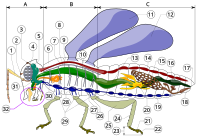
Photo from wikipedia
Laboratory assessments of aqueous metal toxicity generally demonstrate aquatic insects tolerate relatively high concentrations of metals in aqueous exposures; however, mesocosm experiments and field biomonitoring often indicate effects at relatively… Click to show full abstract
Laboratory assessments of aqueous metal toxicity generally demonstrate aquatic insects tolerate relatively high concentrations of metals in aqueous exposures; however, mesocosm experiments and field biomonitoring often indicate effects at relatively low metal concentrations. One hypothesis proposed to reconcile this discrepancy is an increased sensitivity of smaller size classes of organisms. We exposed field colonized benthic communities to aqueous metals in a series of mesocosm experiments. In addition, a novel single-species test system was used to expose first instar, mid-instar, and late instar mayflies (Ephemeroptera, Baetis tricaudatus) to Zn. These experimental approaches tested the hypothesis that small invertebrate size classes are more sensitive than large, mature size classes. Mesocosm results demonstrated strong size-dependent responses of aquatic insects to metals. Smaller organisms generally displayed greater mortality than large, mature individuals, and models were improved when size was included as a predictor of mortality. Size-dependent responses of Baetis spp. occurred in mesocosm experiments and in our single-species test system. The median lethal concentration (LC50) for early instar B. tricaudatus was less than 6% of the previously reported LC50 for late instars. Together, these results suggest that aquatic insect body size is an important predictor of susceptibility to aqueous metals. Toxicity models that account for insect phenology by integrating the natural size progression of organisms have the potential to improve accuracy in predicting effects of metals in the field.
Journal Title: Environmental Science & Technology
Year Published: 2019
Link to full text (if available)
Share on Social Media: Sign Up to like & get
recommendations!